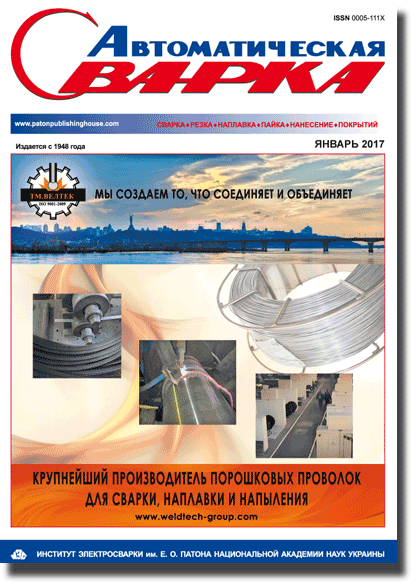| 2017 №01 (06) |
DOI of Article 10.15407/as2017.01.07 |
2017 №01 (08) |

Avtomaticheskaya Svarka (Automatic Welding), #1, 2017, pp. 49-54
Nuclear magnetic spectroscopy study of the structure of liquid glasses for welding electrodes
A.E. Marchenko1, N.V. Skorina1, M.O. Kiselev1 and V.V. Trachevsky2
1E.O. Paton Electric Welding Institute, NASU 11 Kazimir Malevich Str., 03680, Kiev, Ukraine. E-mail: office@paton.kiev.ua
2Technical Center of NASU 13 Pokrovskaya Str., 04070, Kiev, Ukraine. E-mail: trachev@imp.kiev.ua
Abstract
Nuclear magnetic spectroscopy was used to study the structure of silicon-oxygen anions (SOA) in the composition of monobasic (Li, Na, K) and binary (LiNa, LiK, and NaK) liquid glasses. It is found that combinations of different forms of connection reflect the structure of silicon-oxygen anions present in the solution, which determines the change of liquid glass viscosity, depending on their chemical composition. Structure of SOA of monobasic liquid glasses is determined by the kind of modifier ion. The larger its size, the weaker is its destructive action on SOA, with preservation of a larger number of bridge bonds, ensuring a higher level of liquid glass viscosity. Binary mixtures of liquid glasses at certain ratios of alkali oxide fractions, demonstrate synergism of viscosity. The fraction of bridge bonds is higher in such glasses. Synergic increase of viscosity is more pronounced in LiK glasses than in LiNa and NaK analogs, although viscosity of monobasic glasses, from which the mixtures were prepared, was the same. 11 Ref., 3 Tables, 3 Figures.
Keywords: arc welding, welding electrodes, manufacturing technology, liquid glass, liquid glass structure, application of NMR spectroscopy technique
Received: 16.02.17
Published: 18.12.16
References
- Uchino, T., Sakka, T., Iwasaki, M. (1991) Interpretation of hydrated states of sodium silicate glasses by infrared and Raman analysis. Am. Ceram. Soc., 74(2), 306–313. https://doi.org/10.1111/j.1151-2916.1991.tb06880.x
- Bukermann, W.A., Mueller-Warmuth, W., Frichat, G.H. (1992) A further 29Si MAS NMR study on binary alkali silicate glasses. Ber., 65(5), 18–21.
- Maekawa, H., Maekawa, T., Kawamura, K. et al. (1991) The structural groups of alkali silicate glasses determined from 29Si MAS — NMR. Non-Cryst. Sol., 127, 53–64.
- Brykov, A.S., Danilov, V.V., Aleshunina, E.Yu. (2008) State of silicon in silicate and silicon-containing solutions and their binding properties. Prikladnoj Khimii, 81(Issue10), 1589–1593. https://doi.org/10.1134/s1070427208100029
- Brykov, A.S. (2009) Silicate solutions and their application. St.-Petersburg.
- Malyavsky, N.I. (2003) Alkaline-silicate heating materials. Properties and chemical principles of production. Khim. Zhurn., 47(4), 39–45.
- Fedotov, M.A. (2009) NMR of inorganic compounds solutions.
- Anfilogov, V.N., Bykov, V.N., Oslipov, F.F. (2005) Silicate melts. Moscow: Nauka.
- Marchenko, A.E., Skorina, N.V. (1981) Liquid glasses — structured liquids. Information. Kiev: Naukova Dumka, Issue 2, 106–109.
- Marchenko, A.E. (1989) Combined alkaline silicates in production of low-hydrogen electrodes. In: of 2nd Int. School of Countries-Members of CMEA on Metallurgical and Technological Problems of Electrodes with Basic Coating (Sofia, November 1989). Kiev: Naukova Dumka, 1989, 123–130.
- Marchenko, A.E., Skorina, N.V. (2013) Influence of technological factors in manufacture of low-hydrogen electrodes on hydrogen content in the deposited metal. The Paton Welding J., 8, 13–24.
The cost of subscription/purchase order journals or individual articles
| Journal/Currency | Annual Set | 1 issue printed |
1 issue |
one article |
| TPWJ/USD | 384 $ | 32 $ | 26 $ | 13 $ |
| TPWJ/EUR | 348 € | 29 € | 24 € | 12 € |
| TPWJ/UAH | 7200 UAH | 600 UAH | 600 UAH | 280 UAH |
| AS/UAH | 1800 UAH | 300 UAH | 300 UAH | 150 UAH |
| AS/USD | 192 $ | 32 $ | 26 $ | 13 $ |
| AS/EUR | 180 € | 30 € | 25 € | 12 € |
| SEM/UAH | 1200 UAH | 300 UAH | 300 UAH | 150 UAH |
| SEM/USD | 128 $ | 32 $ | 26 $ | 13 $ |
| SEM/EUR | 120 € | 30 € | 25 € | 12 € |
| TDNK/UAH | 1200 UAH | 300 UAH | 300 UAH | 150 UAH |
| TDNK/USD | 128 $ | 32 $ | 26 $ | 13 $ |
| TDNK/EUR | 120 € | 30 € | 25 € | 15 € |
AS = «Automatic Welding» - 6 issues per year;
TPWJ = «PATON WELDING JOURNAL» - 12 issues per year;
SEM = «Electrometallurgy Today» - 4 issues per year;
TDNK = «Technical Diagnostics and Non-Destructive Testing» - 4 issues per year.





